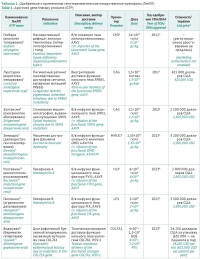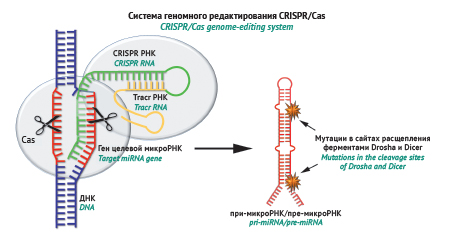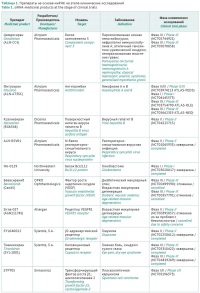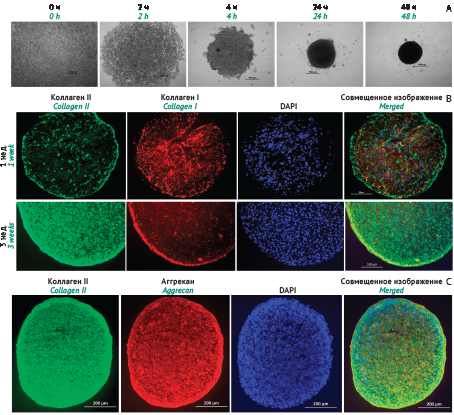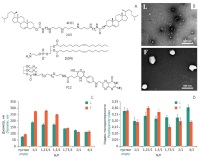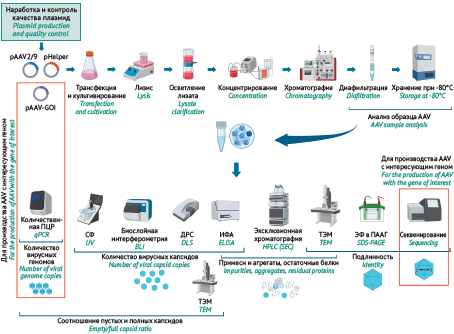ISSUE TOPIC: ADVANCED THERAPY MEDICINAL PRODUCTS
INTRODICTION. Currently, gene therapy based on adeno-associated virus (AAV) vectors faces a number of barriers, both biomedical and technological, which require studying and overcoming for further development of this gene therapy technology.
AIM. This study aimed to analyse the use of gene therapy for a range of hereditary diseases, taking into account the barriers associated with its side effects and insufficient efficacy, the determination of the therapeutic window, and individual characteristics relevant to a particular hereditary disease; additionally, the study aimed to review the approaches to lifting these barriers and increasing the availability of gene therapy through the improvement of technological approaches to production and the reduction of production costs.
DISCUSSION. The authors reviewed the experience accumulated for gene therapy products that were approved or undergoing clinical trials. The study included a gene therapy applicability assessment using several hereditary diseases as a case study. The assessment showed that correct determination of the therapeutic window for a medicinal product and timely diagnosis of a hereditary disease were essential for effective and safe gene therapy. The study considered the strategies used to reduce the risks of adverse events and increase the effectiveness of AAVbased gene therapy. The authors assessed technological advancements in the manufacturing of AAV-based gene therapy products. The most perspective directions were the transition to suspension culture systems, the improvement of bioreactors, the use of new methods and materials for the purification of viral particles, the improvement of transfection systems, and the creation of new host cell lines. Ultimately, this can lead to lower production costs and an increased availability of gene therapy.
CONCLUSION. Currently, gene therapy is used only for a small range of hereditary diseases. Significant barriers to its use are due to insufficient efficacy, risks of adverse events, and high costs for treatment. Ongoing biomedical and technological development should lift many of these barriers and increase access to gene therapy.
INTRODUCTION. The development of malignant neoplasms is associated with changes in the expression of small non-coding RNAs (miRNAs). This emphasises the need for research into the development of miRNA-targeted inhibitors as a promising approach to cancer treatment.
AIM. This study aimed to compare current strategies for suppressing the functional activity of tumour-associated miRNAs based on the use of therapeutic nucleic acids and to determine the application potential of these strategies.
DISCUSSION. This study analysed known oligonucleotide-based miRNA inhibitors with different mechanisms of action. Based on their mechanism of action, miRNA-targeted inhibitors can be classified into two groups. The first group of miRNA-targeted inhibitors exhibits an indirect inhibitory effect, either by blocking functional connections between miRNAs and specific mRNA targets through the use of miRNA-masking oligonucleotides or by introducing mutations into miRNA genes and disrupting gene biosynthesis processes through the use of the CRISPR/Cas system. Despite their relatively high biological potential, these strategies are mostly used as search tools to study miRNA functional roles and molecular interactions in carcinogenesis. The second group of oligonucleotide constructs interacts with miRNA targets directly, which leads to steric blocking or degradation of oncogenic microRNAs. These miRNA-binding oligonucleotide constructs come in a variety of structural variants, including miRNA sponges, RNA zippers, antisense oligonucleotides, and miRNases, which demonstrate high therapeutic potential in vitro and in vivo.
CONCLUSION. The described analysis of the biological properties, therapeutic potential, and key advantages of the developed miRNA-targeted oligonucleotide constructs helps outline the areas for their potential practical application in cancer treatment.
INTRODUCTION. Small interfering RNAs (siRNAs) are among the most promising types of therapeutic nucleic acids aiming at the inhibition of pathogenetically relevant gene expression through the RNA interference mechanism. However, the limited bioavailability and immunogenicity of siRNAs and imperfect delivery systems hinder the clinical potential and applicability of siRNA medicinal products.
AIM. This study aimed to summarise recent advances in the development of siRNA medicinal products and the corresponding delivery systems, review clinical trial results, and outline future development prospects for these medicinal products.
DISCUSSION. This article covers the molecular mechanisms underlying RNA interference, the considerations for siRNA development, and the techniques for effective siRNA delivery. The article dwells upon various systems for nucleic acid delivery to targeted cells. The most promising delivery systems are non-viral systems, including liposomes, exosomes, nanoparticles, polymers, cell-penetrating peptides, and GalNAc ligands. Their main advantages include their ease of complexation with nucleic acids, modification and functionalization potential, favourable safety profile, ability to cross biological barriers, and tropism to target tissues. The article summarises the information that has accumulated over the past few years in clinical trials of siRNA medicinal products for a range of conditions, including metabolic disorders, infections, and cancers, as well as hereditary, ophthalmic, renal, and hepatic diseases. Special attention is paid to siRNA medicinal products undergoing clinical trials (over 10 products) and approved for clinical use (6 products, including MIR 19, the first authorised Russian siRNA medicinal product).
CONCLUSION. Ultimately, siRNA medicinal products are a promising tool for personalised medicine, exhibiting therapeutic potential for a wide range of pathological conditions. Further studies of siRNA medicinal products should aim at improving siRNA production technology to increase their bioavailability and half-life period. In addition, these studies should aim at enhancing delivery systems for these products to mitigate toxicity risks and maximise efficacy.
INTRODUCTION. The current cell-based cartilage repair methods, such as autologous chondrocyte transplantation, are not sufficiently effective, and the surgery is painful and traumatic. Therefore, there is a need for a more effective cell therapy product with a minimally invasive surgical procedure for its implantation into the patient.
AIM. This study aimed to develop a manufacturing technology for the production of an autologous cell-based medicinal product (CBMP) comprising three-dimensional structures (3D-spheroids) based on chondrocytes isolated from the patient’s cartilage tissue, as well as to evaluate its clinical efficacy.
MATERIALS AND METHODS. Autologous chondrocytes isolated from the patient’s cartilage biopsy were propagated in monolayer culture to obtain the required number of cells. Subsequently, the chondrocytes were cultivated on plates with a non-adhesive coating to form 3D spheroids. All CBMP production steps were performed under aseptic conditions in cell culture isolators. The authors used phase-contrast microscopy and immunohistochemical staining with specific fluorescence-labelled antibodies to characterise chondrocyte phenotypes at different stages of cultivation. Genetic stability was controlled by karyotyping. The efficacy of Easytense® was evaluated in a clinical trial using specialised functional tests and the Magnetic Resonance Observation of Cartilage Repair Tissue (MOCART) score. The primary efficacy endpoint was a change in the overall score on the Knee Injury and Osteoarthritis Outcome Score (KOOS).
RESULTS. A manufacturing technology without using animal sera, growth factors, cytokines, or other additives was developed for the production of the autologous CBMP Easytense®. Karyological data confirmed that the chondrocytes retained genetic stability for 3 passages in monolayer culture. When cultured as 3D spheroids, the chondrocytes produced cartilage extracellular matrix proteins (type II collagen, aggrecan), thus acquiring the ability to repair damaged cartilage. The clinical trial demonstrated a statistically significant improvement in knee cartilage 12 months after the transplantation of 3D spheroids derived from autologous chondrocytes. The mean change in the overall KOOS score was 23.8±15.9.
CONCLUSIONS. The clinical trial results indicate that Easytense® is highly effective for cartilage repair. Based on these results, the CBMP has been granted marketing authorisation and introduced into clinical practice in the Russian Federation. Easytense® has the potential to replace endoprosthetics and expensive surgeries abroad.
INTRODUCTION. The use of cationic liposomes is a promising approach to the delivery of therapeutic nucleic acids to target cells because liposomes can protect nucleic acids from degradation by extracellular nucleases. However, to ensure selective delivery to the site of action, this approach needs modification, including liposome surface functionalisation with targeting ligands.
AIM. This study aimed to compare the time courses of the accumulation of a fluorescent-labelled oligonucleotide (FITC-ODN), which simulated a nucleic acid-based medicinal product, in cells with the use of folate receptor-targeted (F) and conventional (L) cationic liposomes.
MATERIALS AND METHODS. F- and L-liposomes were prepared using the polycationic amphiphile 2X3, the zwitterionic helper lipid DOPE, and the folate lipoconjugate F12. Physicochemical characterisation of the liposomes was performed using dynamic light scattering and transmission electron microscopy. Liposome–FITC-ODN complexes were formed at various nitrogen to phosphate (N/P) charge ratios. Flow cytometry, fluorescence microscopy, and confocal microscopy methods were used to study the accumulation of liposome–FITC-ODN complexes in human cervical carcinoma (KB-3-1) and human embryonic kidney (HEK 293) cells.
RESULTS. The prepared F- and L-liposomes were spherical particles with a diameter of 75–100 nm. The authors selected the optimal N/P ratio of 2/1 to obtain complexes of F- and L-liposomes with the FITC-ODN. This N/P ratio yielded homogeneous liposome–FITC-ODN complexes having a polydispersity index below 0.200 and a size of 112.4–125.1 nm. F-liposomes were 25% more efficient than L-liposomes in FITC-ODN delivery to KB-3-1 cells at 90, 120, and 240 minutes after transfection. In the first few minutes of cell transfection, fluorescence and confocal microscopy data on the distribution of liposome–FITC-ODN complexes showed that cationic liposome fluorescence signals colocalised with FITC-ODN signals. Later, FITC-ODN accumulation in the cytoplasm was observed.
CONCLUSIONS. Cationic liposomes demonstrated efficient FITC-ODN delivery into the cytoplasm of cancer cells. F-liposomes enhanced the percentage of transfected cells and improved FITC-ODN delivery compared with L-liposomes. The results obtained can be used in the further development of targeted medicinal products based on therapeutic nucleic acids and liposomes.
INTRODUCTION. The development of adeno-associated virus (AAV)-based gene therapy products in Russia requires establishing reference standards, which are used throughout the pharmaceutical development cycle, and monitoring their stability during the storage period. A preparation of empty capsids of AAV serotype 9 (AAV9) is an appropriate material for a reference standard for empty AAV9 capsids (AAV9 RS).
AIM. This study aimed to develop analytical procedures to evaluate the AAV9 RS physicochemical quality parameters for its characterisation and to study its storage stability.
MATERIALS AND METHODS. Empty AAV9 capsids were produced in HEK293 suspension culture using serum-free medium and optimised transfection parameters. The next steps involved AAV9 clarification, concentration, and purification by affinity chromatography with AAVx resin and diafiltration. The analysis of AAV9 samples used electrophoresis, transmission electron microscopy, enzyme-linked immunosorbent assay (ELISA), size-exclusion chromatography, dynamic light scattering, spectrophotometry, and bio-layer interferometry. The concentration of capsids was measured by ELISA. Analytical procedures for physical titre determination were developed using an AAV9 standard with a known physical titre. The stability study of the AAV9 RS involved storage at –80 °C for 9 months.
RESULTS. Size-exclusion chromatography demonstrated the high purity of the established AAV9 RS, with at least 98% content of the viral capsid monomer. Dynamic light scattering, size-exclusion chromatography, and electron microscopy confirmed that the AAV9 RS was free of aggregates. The stability study showed that the AAV9 RS remained stable for 9 months. Dynamic light scattering and spectrophotometry were deemed optimal methods for routine quality analysis measuring the AAV9 RS physical titre, and bio-layer interferometry was recommended for regular analysis. The viral particle titres determined by these methods ranged from 1.48×1013 to 5.6×1013.
CONCLUSIONS. The AAV9 RS established in this study is suitable for quality control of AAV9-based gene therapy products.
INTRODUCTION. The creation of synthetic adeno-associated virus (AAV) vectors during gene therapy development is a labour-intensive and expensive process. The optimal solution to minimise the time and costs associated with gene therapy development lies in the improvement of methods aimed at assessing AAV vector biodistribution and transduction efficiency in vivo.
AIM. This study aimed to develop a new bioinformatics-based assessment method for synthetic AAV vector libraries to analyse AAV vector biodistribution and transduction efficiency in vivo.
MATERIALS AND METHODS. The production of synthetic AAV vectors involved assigning AAV serotype-specific barcodes (12-nucleotide tags flanked at the 5' end with a sequence encoding the green fluorescent reporter protein). Plasmids carrying unique barcodes were propagated in competent Escherichia coli XL10-Gold cells and used to create two AAV libraries: L1 with a viral genome count of 1010 and L2 with a viral genome count of 1011. AAV production involved HEK293T cell transfection. L1 and L2 library vectors were administered to C57Bl/6N mice by intravenous injection. DNA and RNA were isolated from transduced organs for analysis by next-generation sequencing. The obtained data on DNA and RNA barcode quantities in different murine organs were analysed to assess the biodistribution and transduction efficiency of synthetic AAVs. Barcodes were identified by aligning them to the expected sequences and counted. The resulting values were normalised to the quantity of barcodes in the original library.
RESULTS. Seven viral constructs based on different AAV serotypes were created as part of two AAV libraries. Six of the AAV serotypes were synthetic (sAAV1, sAAV2, sAAV3, sAAV4, sAAV5, and sAAV6). Sequencing of murine organ samples revealed significant quantities of DNA barcodes from both AAV libraries in all organs except the brain. For the L1 library, RNA barcodes were detected at a sufficient level in 4 organs, including the skeletal muscles, the heart, the liver, and the adrenal glands. For the L2 library, in addition to the listed organs, sufficient RNA-barcode levels were observed in the gonads and the kidneys. According to transduction efficiency analysis based on RNA barcode levels adjusted for DNA barcodes, sAAV5 was considered the most promising variant for gene therapy of liver-related diseases, whereas sAAV2 and sAAV6 were recognised as holding the most promise for adrenal diseases.
CONCLUSIONS. The developed bioinformatics-based assessment method for synthetic AAV vector libraries can analyse AAV vector biodistribution and transduction efficiency in the body. The presented approach has the potential for selecting optimal AAV vectors for specific organs and tissues in further gene therapy development.
METHODICAL APPROACHES
INTRODUCTION. The distinctive nature and composition of biological medicinal products present certain challenges for the detection of microbial contamination, which affects the reliability of sterility control results. The main challenges associated with testing biologicals include changes in the appearance and physical properties of culture media or samples, an increased risk of contamination or false-positive results in direct inoculation tests, filtration issues, etc. When drafting product specification files and analytical method validation reports in dossiers for biologicals, manufacturers need adequate, reproducible, and pharmacopoeia-based sterility testing procedures for specific medicinal products, including live and inactivated, viral and bacterial, single- and multi-component vaccines, bacteriophages and interferons, sera and immunoglobulins. These challenges can be addressed through providing recommendations for developing analytical procedures based on compendial methods of direct inoculation and membrane filtration.
AIM. This study aimed to offer key recommendations for the development of sterility testing procedures for biologicals based on pharmacopoeial methods.
DISCUSSION. This article presents a retrospective analysis of the results of reviewing regulatory documentation for biological medicinal products submitted to the testing centre of the Scientific Centre for Expert Evaluation of Medicinal Products in 2021–2023. Having considered major issues with the analytical procedures described in the Sterility section of regulatory submissions, the authors offer the following recommendations for addressing these issues. The authors advise against using low-pH Sabouraud culture media to test blood products by direct inoculation. Biologicals containing mercury preservatives should be tested using a thioglycollate medium at two temperature settings. When testing various biologicals, analysts should refrain from plugging vials with cotton gauze. Instead, they should pour culture media into glass vials with rubber stoppers and crimps. Biologicals in large primary packaging (≥10 mL) should be tested by membrane filtration. Membrane filtration tests for biologicals should use solvents and rinsing agents selected in validation studies. It is also recommended to set the maximum volume of a biological medicinal product that can be filtered through a membrane filter. A reduction in the filtration speed is recommended to minimise foaming when testing blood products.
CONCLUSION. The recommendations presented in this article can guide the development of sterility testing procedures for inclusion in the relevant section of regulatory submissions for biologicals. Manufacturers, control laboratories, and regulatory authorities may implement these recommendations to harmonise their approach to sterility testing of biologicals.
ISSN 2619-1156 (Online)




